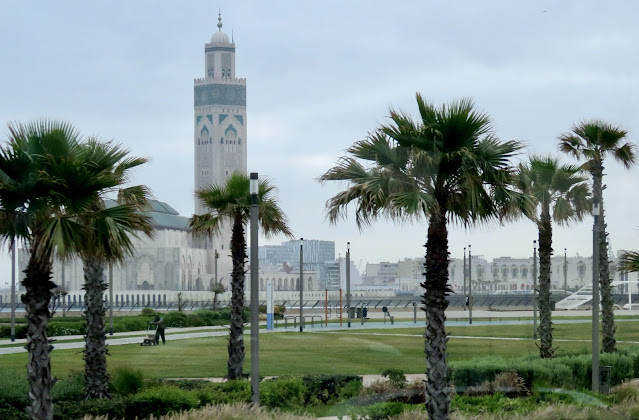Monday, 22 April 2024
Sailing from Gibraltar to Melilla, Spanish North Africa
Today is perfect for a quiet day at sea as we sail from the tip of Gibraltar to one of two Spanish enclaves on the northern Mediterranean coast of Morocco: Cueta and Melilla. There is a long and controversial history of how these two small pieces of land were carved out of Morocco and ceded to Spain. I will give you more information about that when the blog catches up to next Tuesday.
Thursday, 18 April 2024
Sailing from Lanzarote to Casablanca, Morocco
We spend the first sea day of this cruise as we sail eastward from the Canary Islands to the central coast of Morocco. There are so many activities on board all morning, it is difficult to choose. So after breakfast Will and I decide to settle in for a long nap after all these days of touring and sailing.
After lunch we both attend a lecture by guest speaker, Karen Worrell (from Scotland): "Gibraltar: a Gateway to History, Culture, and Scenic Splendors." The British occupation/ownership of this strategic spit of land separating the Atlantic Ocean and the Mediterranean Sea is complicated and still contentious. Although thousands of Spaniards cross the border--in the middle of the airport runway--everyday, relations between Spain and Gibraltar are not comfortable. But more on that when we arrive in Gibraltar next week.
The other major sea day activity is the ship-wide "Block Party." Scheduled on every Seabourn cruise, passengers are invited out of their suites to meet with officers and crew who travel from deck to deck--of course they are accompanied by drinks and snacks. It's a chance for passengers to meet their neighbors and to chat with crew members.
We have dinner tonight in Solis, the one dining venue that requires reservations. I will describe that experience later on when I dedicate a blog to the Quest itself.
Friday, 19 April 2024
Casablanca, Morocco
Ah, the romantic mystery of Casablanca created by Hollywood movies! Too bad there is little of that atmosphere in the actual city. In fact, one of the guide books I consulted says that except for the main mosque and the old city, "the city of Casablanca for the rest is not particularly interesting. But we do have a full day here, from 7am to 9pm.
Will takes a four-hour morning shore excursion, "Casablanca Highlights & Hassan II Mosque," that allows him to visit inside the mammoth mosque, designed by Frenchman Michel Pineau and constructed from 1986 to 1993. It is the second largest mosque in Africa and 14th largest in the world. Its 689-foot minaret is the second tallest in the world. A maximum of 105,000 worshippers can gather together for prayer: 25,000 inside the mosque hall and another 80,000 on the mosque's outside ground.
His tour also visits some older neighborhoods, the Notre Dame de Lourdes Church, the oceanfront corniche, and the United Nations Square in the center of the city.
 |
| Notre Dame de Lourdes Church |
 |
| United Nations Square: Post-Modern City Government Building |
 |
| United Nations Square: French Consulate |
 |
| United Nations Square: Court of Justice |
My own shore excursion, "Casablanca & Rabat," lasts a little longer at 10 hours and includes tours of both cities. As the bus leaves the port we have a quick view of Rick's Cafe, one of the chief tourist fakes of the city--the original one is on a movie studio in California.
We drive south along the oceanfront corniche, passing many large murals on the inland side.
 |
| The Magic of African Mirrors |
 |
| Andalusian Garden |
 |
| Entrance to the Kasbah |






















__03.jpg)